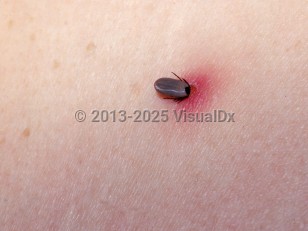Tick bite in Adult
Alerts and Notices
Important News & Links
Synopsis

Ticks are arachnids that live in wooded and grassy areas. Ticks attach themselves to a human host as the person brushes past leaves, grass, etc. Ticks do not jump or fall on a person. Once on a host, ticks move to a warm and moist location (eg, armpit, groin, back of the knee, hairline), where they burrow into the host's skin and feed off their blood.
While most ticks are harmless, some carry disease and may transmit illness (eg, Lyme disease, Rocky Mountain spotted fever, Colorado tick fever) to their host. Certain ticks can even inject venom that causes temporary paralysis in their host (called tick paralysis).
Bites from some Amblyomma and Ixodes (and possibly Haemaphysalis) species have been associated with the subsequent development of allergies to mammalian meat (eg, beef, pork) in a small number of patients. It is thought that the allergy is mediated by induced IgE antibodies to alpha-gal (galactose-alpha-1,3-galactose), a mammalian oligosaccharide. Individuals with elevated IgE titers to alpha-gal have experienced urticaria, angioedema, and anaphylaxis symptoms either immediately or 3-6 hours (delayed onset) after ingesting mammalian meat. Exactly how the tick bite leads to development of this allergy is unclear. Implicated tick bites have been noted to itch for 2 or more weeks. A blood test for these IgE antibodies exists.
While most ticks are harmless, some carry disease and may transmit illness (eg, Lyme disease, Rocky Mountain spotted fever, Colorado tick fever) to their host. Certain ticks can even inject venom that causes temporary paralysis in their host (called tick paralysis).
Bites from some Amblyomma and Ixodes (and possibly Haemaphysalis) species have been associated with the subsequent development of allergies to mammalian meat (eg, beef, pork) in a small number of patients. It is thought that the allergy is mediated by induced IgE antibodies to alpha-gal (galactose-alpha-1,3-galactose), a mammalian oligosaccharide. Individuals with elevated IgE titers to alpha-gal have experienced urticaria, angioedema, and anaphylaxis symptoms either immediately or 3-6 hours (delayed onset) after ingesting mammalian meat. Exactly how the tick bite leads to development of this allergy is unclear. Implicated tick bites have been noted to itch for 2 or more weeks. A blood test for these IgE antibodies exists.
Codes
ICD10CM:
W57.XXXA – Bitten or stung by nonvenomous insect and other nonvenomous arthropods, initial encounter
SNOMEDCT:
95898004 – Tick bite
W57.XXXA – Bitten or stung by nonvenomous insect and other nonvenomous arthropods, initial encounter
SNOMEDCT:
95898004 – Tick bite
Look For
Subscription Required
Diagnostic Pearls
Subscription Required
Differential Diagnosis & Pitfalls

To perform a comparison, select diagnoses from the classic differential
Subscription Required
Best Tests
Subscription Required
Management Pearls
Subscription Required
Therapy
Subscription Required
References
Subscription Required
Last Updated:02/18/2018
 Patient Information for Tick bite in Adult
Patient Information for Tick bite in Adult
Premium Feature
VisualDx Patient Handouts
Available in the Elite package
- Improve treatment compliance
- Reduce after-hours questions
- Increase patient engagement and satisfaction
- Written in clear, easy-to-understand language. No confusing jargon.
- Available in English and Spanish
- Print out or email directly to your patient
Upgrade Today

Tick bite in Adult

